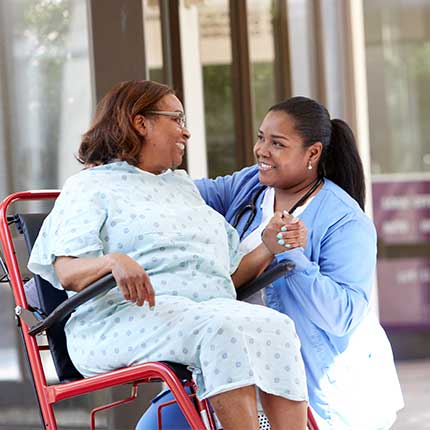Healthy Living: Orthopedics
The Bare Bones of Osteoporosis
No bones about it, osteoporosis can be a serious medical condition that can cause permanent pain, may limit mobility and can even cause people to lose height. The good news is that osteoporosis can be prevented and treated. And, because bones are living, growing tissue, it’s never too late to start protecting your bones and preventing fractures.
What is Osteoporosis?
Osteoporosis – which means “porous bone” – is a bone disease that develops when bones become weak and susceptible to breaking easily from a fall or, in more serious cases, from a minor bump or even just a sneeze.
A healthy bone, viewed under a microscope, looks like a honeycomb. When osteoporosis occurs the holes and spaces in the honeycomb increase in size, causing the bones to lose density or mass and develop abnormal tissue structure. This weakens the bones, making them more likely to break.
According to the National Osteoporosis Foundation (NOF), approximately 54 million Americans have osteoporosis or low bone mass. Studies show that one in two women and up one in four men age 50 and older will break a bone due to osteoporosis.
Signs of Osteoporosis
Osteoporosis is often called a ‘silent disease’ because you cannot feel your bones weakening. The first sign of osteoporosis may be a bone that has broken too easily. Other signs of osteoporosis include losing height or getting shorter over time or a humped back, stooped posture or curving spine.
How Do I Know if I Have Osteoporosis?
As with many health conditions, early diagnosis is key. You can find out of you have osteoporosis or if you should be concerned about your bones by getting a bone mineral density (BMD) test. During a BMD, a special machine measures your bone density, calculating the amount of bone mineral you have in certain bones. The test determines whether you have normal bone density, low bone density (osteopenia) or osteoporosis.
Who Should Get a Bone Mineral Density Test?
- Women age 65 or older
- Men age 70 or older
- Women of menopausal or postmenopausal age with risk factors (low body weight, broken bones or height loss)
- Men age 50-69 with risk factors (low body weight, broken bones or height loss)
If you are at risk, ask your doctor about getting a bone mineral density test.
Preventing Osteoporosis
There is much you can do to protect your bones throughout your life. Remember, bones are living, growing tissue. When you lose old bone, you make new bone.
- Get enough calcium and vitamin D - The two most important nutrients for bone health are calcium and vitamin D, which help build strong, dense bones when you are young and keep them strong throughout your life. A calcium-rich diet includes dairy, nuts, leafy greens and fish. Sources of vitamin D include sunlight, a few foods (wild-caught mackerel, salmon and tuna) and vitamin D supplements.
- Eat foods that are good for bone health, including fruits and vegetables.
- Avoid smoking and limit alcohol to two to three drinks each day.
- Exercise - Both high-impact and low-impact, weight-bearing exercises help build bones and keep them strong.
- High-impact, weight-bearing exercises are dancing, aerobics, tennis, hiking, jogging/running, jumping rope and climbing stairs.
- Low-impact, weight-bearing exercises are low-impact aerobics, using elliptical training machines and stair-step machines and walking at a fast pace on a treadmill.
Remember, it’s never too late to take steps to protect your bones. Keeping your bones healthy to prevent osteoporosis should be a priority.
Source:
National Osteoporosis Foundation


